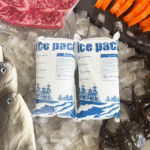Pack de gel de glace carbonique bon marché pour l'insuline: How to Choose the Best Option for Temperature-Controlled Shipping
Introduction:
Ensuring that insulin remains within the proper temperature range during transport is vital for preserving its effectiveness. UN cheap dry ice gel pack for insulin offers an affordable yet reliable way to achieve this goal. This article will explore how to select the best dry ice gel pack, focusing on cost, efficacité, and safety for insulin shipping.
-
How dry ice gel packs maintain the proper temperature for insulin during transport.
-
The key factors to consider when selecting a cheap dry ice gel pack for insulin shipping.
-
The latest innovations in cold chain solutions for insulin and other pharmaceutical shipments.
Why Do You Need a Cheap Dry Ice Gel Pack for Insulin?
A cheap dry ice gel pack for insulin combines the cooling power of dry ice with a gel or phase-change material (PCM), offering extended temperature control for insulin shipments. Insulin needs to remain between 2°C and 8°C to retain its potency, and dry ice gel packs help achieve that by providing an effective cooling solution without the expense of powered refrigeration systems.
Key Benefits of Using Dry Ice Gel Packs for Insulin:
-
Rentable: These gel packs offer an affordable solution for cold chain shipping, ideal for businesses looking to keep insulin shipments within budget while maintaining safe temperatures.
-
Longue durée de refroidissement: Dry ice provides a longer cooling duration than regular ice packs, making it especially useful for longer shipping times or shipments through warm climates.
Types of Insulin Shipping Solutions
| Shipping Solution | Durée de refroidissement | Coût | Plage de température | Cas d'utilisation idéal |
|---|---|---|---|---|
| Packs de gel de glace sec | 48-72 heures | Faible | -78.5°C | Insuline, Biopharmaceutiques |
| Packs de glace ordinaires | 24 heures | Moyen | 0° C à 5 ° C | General Cold Shipping |
How to Choose the Right Dry Ice Gel Pack for Insulin Shipping?
When selecting a dry ice gel pack for insulin, it is essential to evaluate several key factors to ensure safe, efficace, and affordable shipping.
Consideration 1: Durée de refroidissement
Insulin must stay within the 2°C to 8°C range during shipping. Dry ice gel packs that provide cooling for at least 48 hours are ideal for ensuring the stability of insulin.
Consideration 2: Rentabilité
To make the most cost-effective choice, look for dry ice gel packs that offer reliable cooling without significantly raising shipping costs. Compare different brands and types to find the most affordable option that meets your needs.
How Do Dry Ice Gel Packs Work?
Dry ice gel packs use phase-change material (PCM) technologie, allowing them to absorb heat and maintain a consistent temperature throughout the shipping process. The dry ice sublimates at -78.5°C, providing extreme cold, while the PCM prevents direct contact between the dry ice and insulin, ensuring it doesn’t freeze.
How to Use Dry Ice Gel Packs in Insulin Shipping:
To maximize the effectiveness of dry ice gel packs for insulin shipping, place the gel pack in the center of the package and surround it with insulation. It is critical to ensure the correct quantity of gel pack is used to maintain the required temperature for the entire journey.
Exemple du monde réel:
A pharmaceutical company reduced its insulin spoilage rate by 20% by switching to cheap dry ice gel packs. This change ensured that the insulin stayed within the desired temperature range, improving shipping efficiency and reducing waste.
2025 Trends in Temperature-Controlled Pharmaceutical Shipping
As cold chain logistics evolves, new technologies and innovations are shaping the future of temperature-sensitive shipments like insulin.
Latest Trends in Dry Ice Gel Pack Technology
-
Emballage durable: New developments in biodegradable dry ice gel packs aim to reduce the environmental impact of shipping while still maintaining high performance.
-
Isolation améliorée: Advances in insulation materials for shipping boxes now help maintain optimal temperatures without additional packing materials, making the cold chain more efficient and cost-effective.
Insistance au marché:
The demand for reliable and affordable dry ice gel packs is growing, especially in the e-commerce and pharmaceutical sectors. Companies are increasingly looking for cost-effective and eco-friendly solutions that align with sustainability goals while ensuring product integrity during transport.
FAQ
Q1: How long do dry ice gel packs last for insulin shipping?
Dry ice gel packs typically last 48-72 heures, providing enough time for safe delivery of insulin within the required temperature range.
Q2: Can dry ice gel packs be reused?
Oui, many dry ice gel packs are reusable, making them a sustainable and cost-efficient option for temperature-sensitive shipments.
Q3: What is the ideal temperature for insulin shipping?
The ideal temperature for shipping insulin is between 2°C and 8°C to ensure the medication remains effective.
Conclusion et recommandations
Cheap dry ice gel packs are an ideal solution for transporting insulin, offering both affordability and reliability. By selecting the right gel pack based on cooling duration, rentabilité, and insulation needs, you can improve efficiency and reduce shipping costs.
Étapes suivantes:
-
Évaluez vos besoins d’expédition: Consider the duration and environmental conditions of the shipment before choosing the right dry ice gel pack.
-
Consider reusable options: To reduce long-term costs, opt for dry ice gel packs that can be reused.
-
Choose eco-friendly options: Look for dry ice gel packs that are made from sustainable materials, aligning with environmental goals.
À propos du tempk
Et tempk, nous sommes spécialisés dans la fourniture de solutions innovantes pour la chaîne du froid. Our range of dry ice gel packs ensures reliable, cost-effective temperature control for sensitive products like insulin. With a focus on sustainability and performance, Tempk stands out as a trusted partner in the cold chain logistics sector.
























